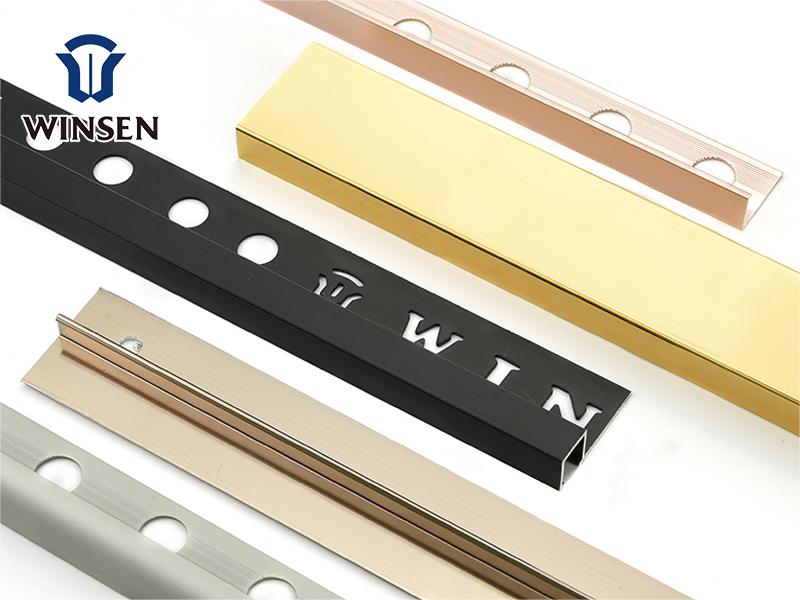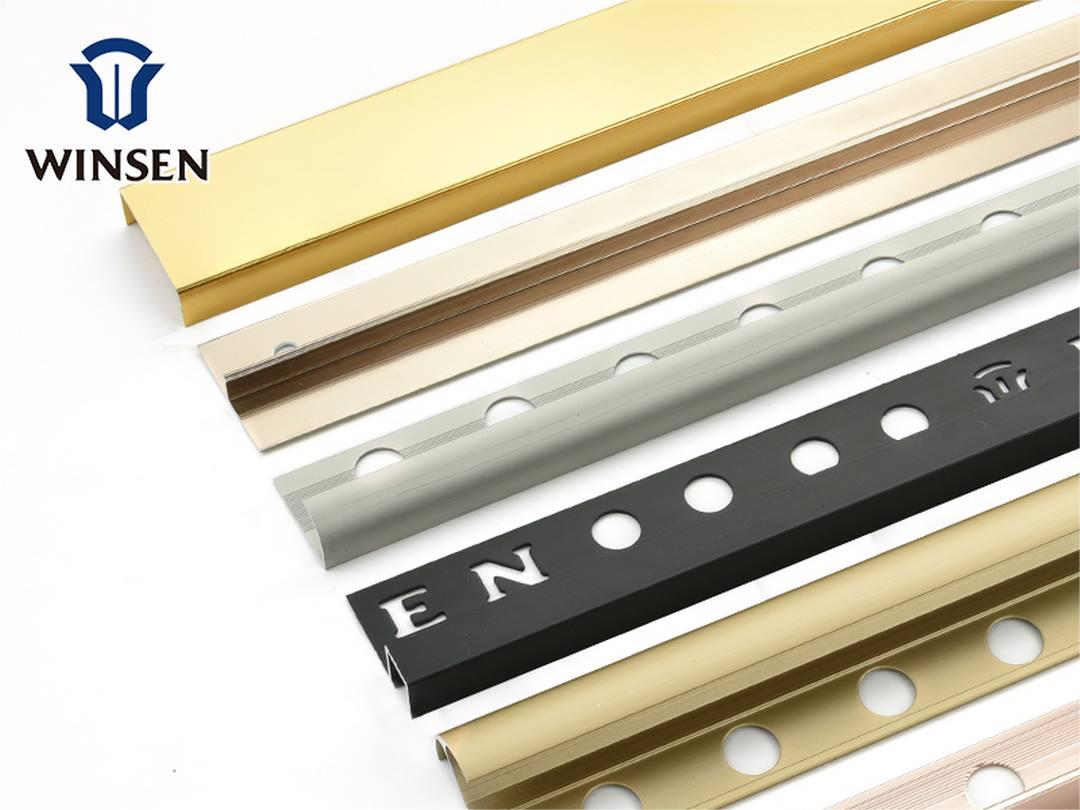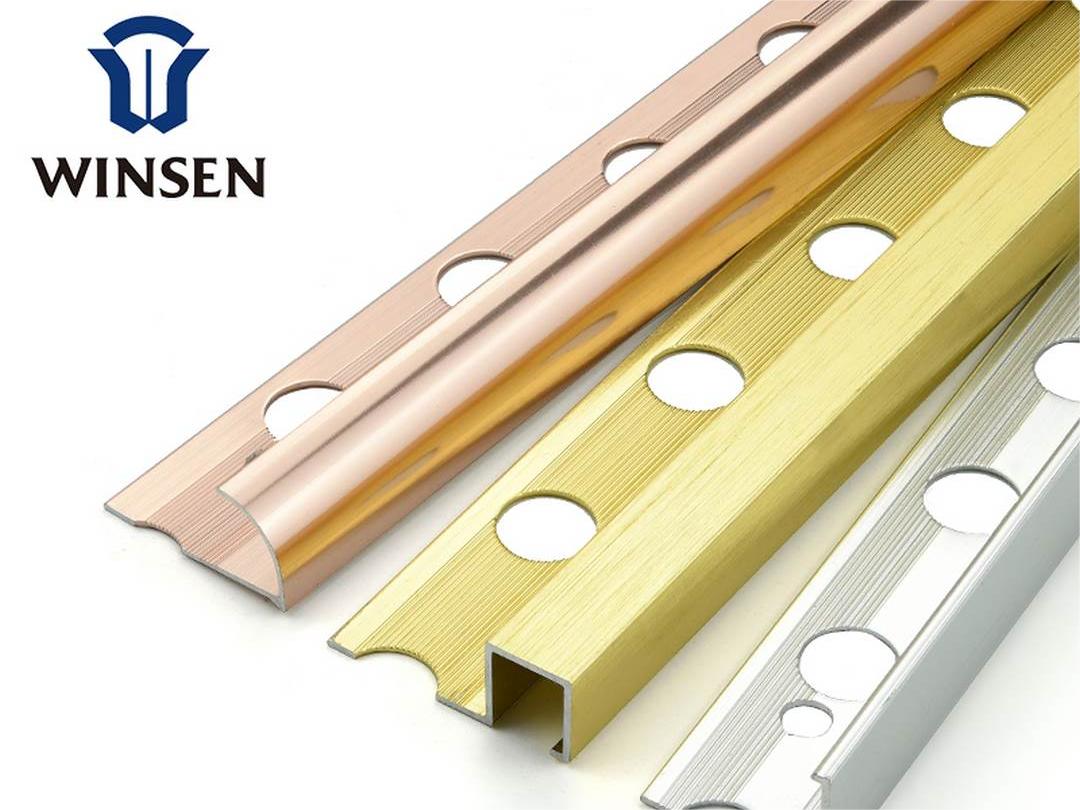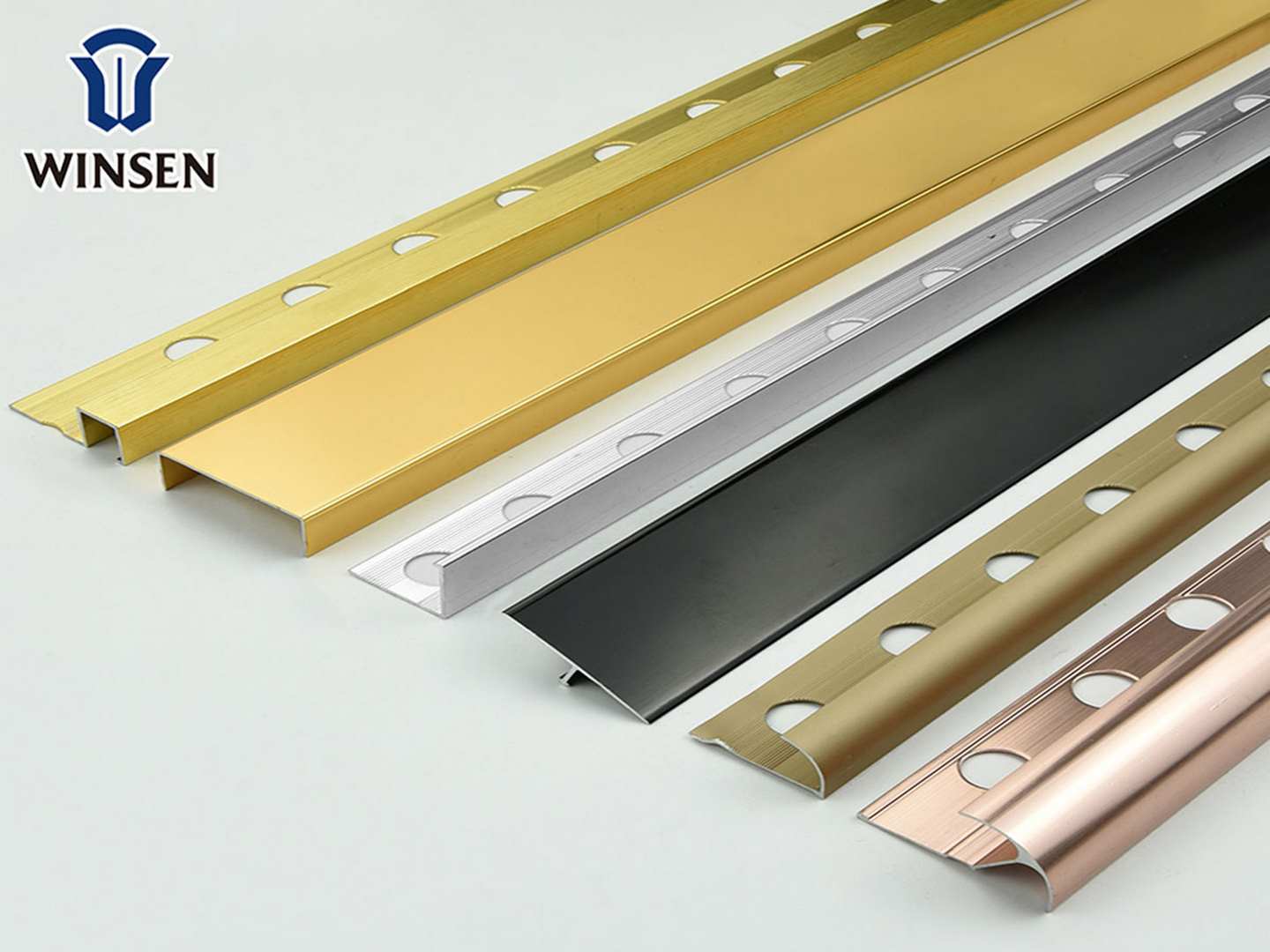The Ultimate Guide to Aluminium Metal Trim: Uses, Benefits, and FAQs
Introduction
Many tile edge trim manufacturers curious about aluminium metal trim, you're in the right place.
Let's explore its features, designs, and practical applications together.
We'll delve into five crucial aspects: what aluminium tile trim is, its uses, whether to choose plastic or metal, how to prevent rust, and its suitability for showers.
Aluminium metal trim offers various designs, from sleek minimalist lines to more decorative options, catering to diverse aesthetic preferences.
By the end of this article, you'll have a clear understanding of how aluminium metal trim can enhance your projects with its durability, style, and versatility. Ready to dive in?
About “Best Price Square Edge Trim Factory”, “Quadrant edge trim manufacturers” hope it can help you too.
What is Aluminium Tile Trim?
Source and Purpose:
Aluminium tile trim is a decorative and protective material used for treating the edges of tiles.
Typically made from aluminum alloy, it serves multiple functions in both residential and commercial tiling projects.
Merit:
Protecting Tile Edges: Aluminium tile trim provides robust protection for tile edges, preventing damage or breakage from external forces. This is crucial in high-traffic areas where tiles are more susceptible to wear and tear.
Beautiful Decoration: The trim offers a clean and elegant transition for tile installations, enhancing the overall aesthetic appeal. It ensures that the edges look polished and refined.
Variety of Styles and Colors: Available in numerous styles and colors, aluminium tile trim can complement various tile designs and décor themes, allowing for versatile and customizable installations.
Easy to Install: Designed for ease of installation, aluminium trim can be laid simultaneously with the tiles or added afterward. This flexibility simplifies the construction process.
Strong Durability: The aluminium alloy material is inherently anti-corrosion, anti-rust, and wear-resistant, ensuring a long lifespan and minimal maintenance.
Aluminium tile trim is commonly used in areas such as tile corners, the junctions of floors and walls, and countertop edges.
By providing a professional finish and added durability, it helps achieve a more polished and lasting decorative effect.

What is Aluminium Trim Used For?
Source and Purpose:
Aluminium trim is extensively utilized in construction and interior decoration due to its versatility and durability.
Its primary role is to provide both functional and aesthetic enhancements across a variety of applications.
Merit:
Tile Edges: Aluminium trim protects and decorates tile edges, preventing chipping and damage while ensuring a neat, professional transition.
Wall Corner Protection: It safeguards wall corners from impact damage, enhancing durability and adding a polished look to the room.
Floor Transition: Used to create smooth transitions between different flooring materials, aluminium trim reduces the risk of tripping and adds a cohesive finish.
Door and Window Frames: By decorating and protecting the edges of door and window frames, aluminium trim enhances the overall aesthetic and structural integrity.
Furniture Edges: Applied to the edges of furniture such as cabinets, tables, and bookshelves, aluminium trim offers protection and an elevated design element.
Ceiling and Wall Decoration: Decorative lines made from aluminium trim on ceilings and walls add depth, layers, and visual interest to interior spaces.
Stair Treads: Aluminium trim provides edge protection for stair treads, making them non-slip and wear-resistant, thereby improving safety.
Mirror Frames and Picture Frames: It decorates and protects the edges of mirrors and picture frames, improving their visual appeal and longevity.
Advantages:
Aluminium trim is renowned for being lightweight, durable, and corrosion-resistant, making it suitable for a wide range of indoor and outdoor applications.
Its ease of installation further contributes to its popularity, as it simplifies the process of achieving a professional finish in construction and decoration projects.
With its broad spectrum of uses, aluminium trim is a valuable asset in creating functional and aesthetically pleasing environments.

Should I Use Plastic or Metal Tile Trim?
Source and Purpose:
Choosing between plastic and metal tile trim depends on several factors, including the specific application, personal preferences, and budget.
Each material offers distinct advantages and disadvantages that can impact the outcome of your project.
Plastic Tile Trim:
Pros:
Lower Price: Plastic trim is generally more affordable than metal trim, making it ideal for budget-conscious projects.
Variety of Colors and Styles: With a wide array of colors and styles, plastic trim can easily match the color and design of your tiles.
Corrosion Resistance: Plastic is inherently resistant to corrosion, making it suitable for moist environments like bathrooms and kitchens.
Easy to Cut and Install: Lighter and easier to work with, plastic trim can be cut and installed using standard tools.
Cons:
Poor Durability: Plastic trim is less durable than metal trim and can be more easily damaged by impacts and wear.
Limited Aesthetics: Often, plastic trim lacks the high-end appearance and texture of metal trim.
Expansion and Contraction: Plastic may expand or contract with temperature changes, potentially affecting its lifespan.
Metal Tile Trim (e.g., Aluminium Alloy):
Pros:
High Durability: Metal trim is extremely durable, capable of withstanding significant impacts and wear.
High-End Appearance: Metal edging provides a sophisticated look and feel, adding a premium quality to the decor.
Multiple Options: Available in various metals like aluminium, stainless steel, and brass, metal trim can suit different styles and preferences.
Heat and Cold Resistance: Metal is stable under extreme temperatures and less likely to deform.
Cons:
Higher Price: Generally more expensive than plastic, metal edging might not be ideal for tight budgets.
Difficult to Install: Heavier and requiring specialized tools and skills, metal trim can be more challenging to cut and install.
Corrosion Problems: Some metals can corrode in humid environments, so it's crucial to choose corrosion-resistant or treated materials.
Selection Suggestions:
Limited Budget and Color Variety Needs: Opt for plastic tile edging.
Durability and High-End Appearance: Choose metal tile edging.
Humid Environment (e.g., Bathroom, Kitchen): Select corrosion-treated metal or high-quality plastic edging.
High-Traffic Areas: For areas like living rooms and corridors, metal edging is recommended for its enhanced durability.
By evaluating these factors, you can choose the best tile trim material to meet your project's requirements, ensuring both functionality and aesthetics.

How Do You Keep Aluminum From Rusting?
Source and Purpose:
While aluminium itself doesn't rust as iron and steel do, it can oxidize, forming a protective layer of aluminium oxide.
This layer helps prevent further corrosion, but additional measures can be taken to enhance its longevity and appearance.
Merit:
Anodizing:
Anodizing is an electrochemical process that thickens the natural oxide layer on the surface of aluminium.
This enhanced oxide layer provides superior protection against oxidation and can be dyed for decorative purposes. Anodized aluminium is widely used in architectural and consumer products due to its increased durability and aesthetic versatility.
Coating:
Applying protective coatings such as powder coating or paint can effectively shield aluminium from oxidation and corrosion.
This method is prevalent in building materials and automotive parts.
Coatings not only protect but also add color and texture, enhancing the material's visual appeal and resistance to environmental factors.
Electroplating:
Electroplating involves depositing a thin layer of metal, such as nickel or chromium, onto the aluminium surface.
This process boosts the aluminium's resistance to corrosion and wear.
Electroplated aluminium components are commonly found in electronics, automotive parts, and household fixtures.
Corrosion Inhibitors:
Special corrosion inhibitors can be applied to aluminium surfaces to form a protective film.
These inhibitors prevent oxidation and extend the material's service life.
They are particularly useful in industrial settings where aluminium is exposed to harsh conditions.
Keep Dry:
Minimizing exposure to moisture is key to preventing aluminium corrosion.
Keeping aluminium products dry and using desiccants or moisture-proof bags during storage can significantly reduce the risk of oxidation.
Regular Cleaning:
Routine cleaning removes dirt and impurities that could corrode aluminium.
Use a neutral detergent and a soft cloth to clean the surface, avoiding acidic or alkaline cleaners that can damage the oxide layer.
Avoid Contact with Other Metals:
Aluminium can undergo electrochemical corrosion when in direct contact with metals like copper or iron.
To prevent this, avoid direct metal-to-metal contact during installation and use insulating materials to separate different metals.
By implementing these measures, you can ensure that aluminium remains in excellent condition, maintaining its structural integrity and appearance over time.

Can I Use Aluminium Trim in the Shower?
Source and Purpose:
Aluminium trim can indeed be used in showers, offering both functional and aesthetic benefits.
However, to ensure its longevity and effectiveness, several considerations and maintenance practices should be followed.
Advantages:
Good Waterproofness: Aluminium is inherently waterproof and does not rust like some other metals, making it an excellent choice for wet environments such as showers.
Lightweight and Durable: Aluminium's lightweight nature makes it easy to handle and install, while its durability ensures it can withstand daily wear and tear.
Aesthetics: Aluminium trim provides a clean, tidy edge treatment that enhances the overall appearance of the shower, contributing to a sleek and modern look.
Precautions:
Anodizing: Opt for anodized aluminium trim, which has increased corrosion resistance and durability.
This treatment adds a protective layer that prevents oxidation and extends the trim's lifespan.
Regular Cleaning: Maintain the trim by regularly cleaning it to avoid water accumulation and soap residue.
Use a neutral detergent and a soft cloth to clean, avoiding acidic or alkaline cleaners that could damage the trim.
Avoid Electrochemical Corrosion: Prevent direct contact between aluminium and other metals like copper or iron to avoid electrochemical corrosion.
Use insulating materials during installation to separate aluminium from other metals.
Installation Quality: Ensure high-quality installation by using waterproof sealant to seal edges and joints, preventing moisture from penetrating and causing damage.
Selection for High Humidity Environment: In highly humid environments, aluminium alloy may show slight oxidation.
However, this oxide layer actually serves as a protective barrier. Choose high-quality, specially treated aluminium trim to further enhance its anti-corrosion performance.
Specific Steps:
Choose Suitable Aluminium Alloy Decorative Strips: Select aluminium alloy trims designed specifically for humid environments, preferably anodized products.
Measuring and Cutting: Accurately measure and cut the aluminium trim to fit the required dimensions.
Fixing and Sealing: Use appropriate adhesives or fixings to secure the trim in place and apply waterproof sealant to all joints.
Regular Maintenance: Periodically check and clean the trim to keep it in optimal condition.
By following these guidelines, you can effectively use aluminium trim in your shower, ensuring both its functionality and aesthetic appeal are maintained over time.

Conclusion
Aluminium metal trim is a versatile and durable solution for various construction and decoration needs.
Understanding what aluminium tile trim is reveals its role in protecting and beautifying tile edges.
Its diverse uses extend from floor transitions to furniture edges, enhancing both functionality and aesthetics.
Choosing between plastic and metal trim depends on budget, durability, and the desired look.
Aluminium’s resistance to rust can be maintained through anodizing, coating, and regular cleaning.
Finally, using aluminium trim in showers proves practical due to its waterproof nature, with proper installation ensuring long-lasting performance.
These insights help resolve issues of durability, aesthetics, and maintenance in construction projects, making aluminium trim a valuable choice.
Welcome to know more detailed information about products in WINSEN.
